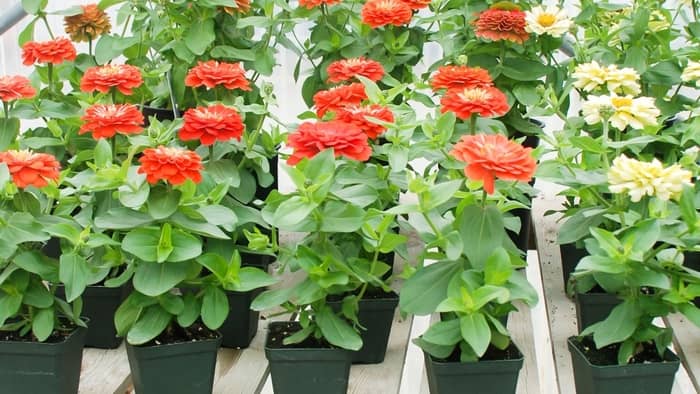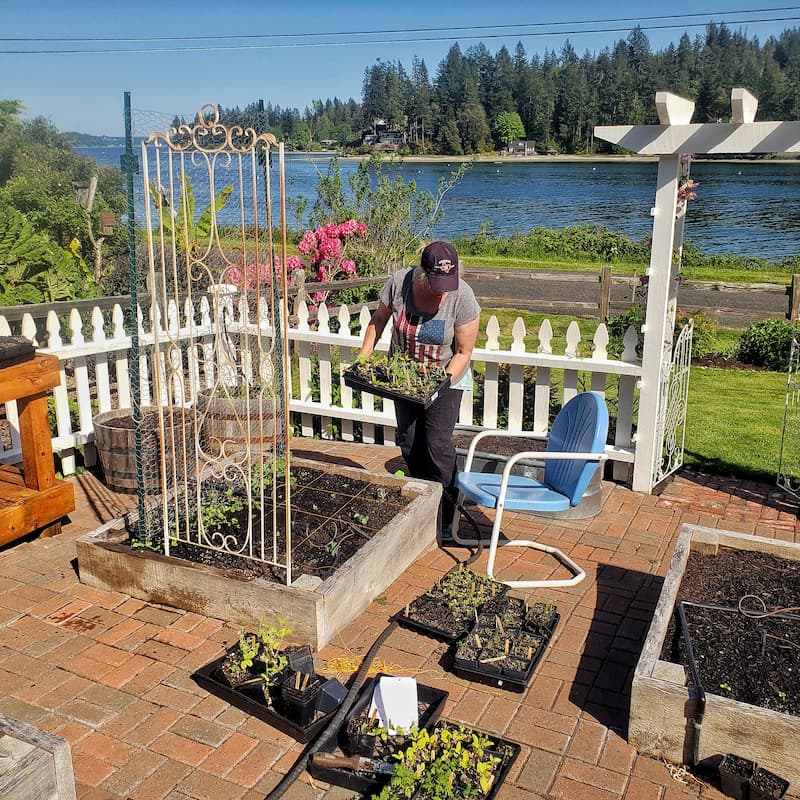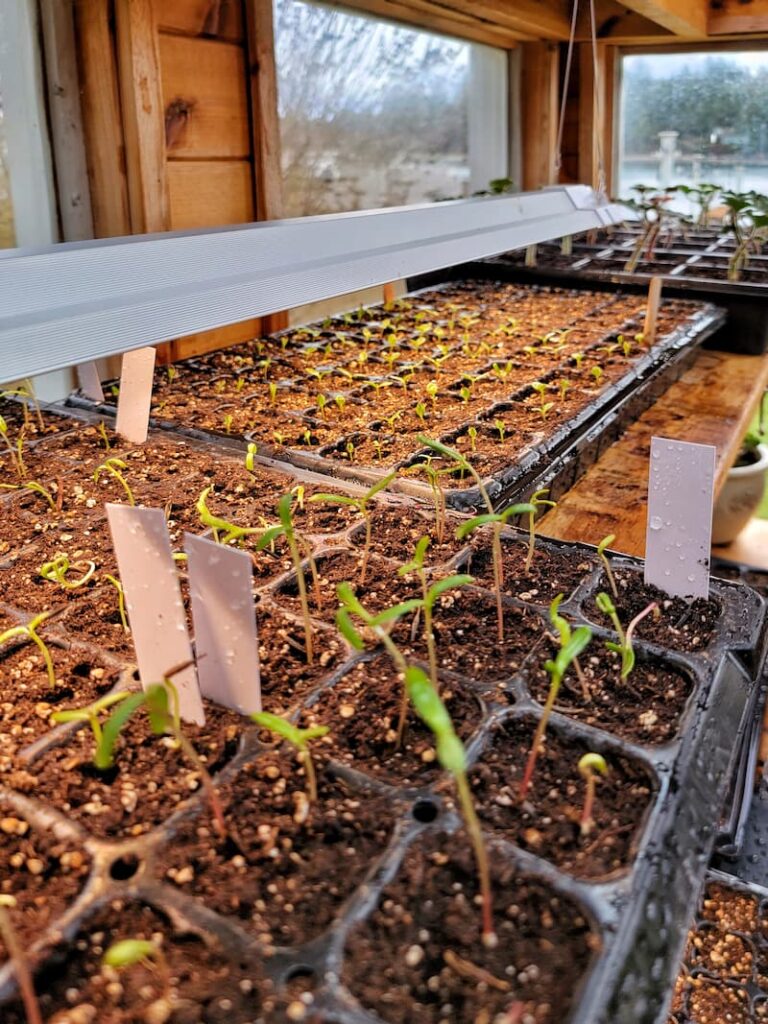Are you considering growing a cut flower garden but want the process to be simple and fun? This guide will help you choose some of the easiest flowers to grow indoors from seed, giving you more time to enjoy your garden.
For beginners, growing flowers from seed can be gratifying. There’s something truly amazing about watching a single seed turn into the most stunning flower.
Follow along for tips on which cut flowers are the easiest to grow. This will give you more time and energy to enjoy your cut flower garden rather than work in it all the time!
As an Amazon affiliate, I earn from qualifying purchases at no extra cost to you. My blog contains other affiliate links for your convenience as well. Click here to read my privacy policy.
Starting flowers from seed indoors is a great way to get a head start on the growing season. By sowing seeds inside and growing young seedlings under lights or on a bright windowsill, we can have flowers ready to transplant to the garden weeks before the last frost date. This gives our flowers a longer season to grow, bloom, and produce for us.
When starting flowers from seed, it’s important to choose varieties that do well with indoor sowing and transplanting Some flowers resent having their roots disturbed and are best direct sown into the garden Others may be fussy and prone to damping off disease when started too early indoors.
To help you get the most success, here is a list of the top flowers to start from seed indoors.
Best Annual Flowers to Start Indoors
Annual flowers complete their entire lifecycle in one season Some bloom right up until frost while others fade when summer heat hits By starting annuals indoors, we can maximize their flowering potential. Here are some great ones
Marigolds
Marigolds (Tagetes spp.) are easy to grow from seed indoors. They germinate quickly and young seedlings grow rapidly under lights or on a sunny windowsill. Marigolds come in a rainbow of flower colors including yellow, gold, orange, red, and white. Most bloom prolifically from late spring until fall frost. By getting them going indoors early, you’ll have marigolds flowering sooner and over a longer period.
Zinnias
Zinnias (Zinnia spp.) are another annual that’s very simple to start from seed indoors. They love warm soil so get them going 4-6 weeks before your last frost date. Zinnias come in a huge range of bright, dazzling colors and flower forms. The more you harvest, the more they bloom. Start a few batches every 2-3 weeks for non-stop color.
Cosmos
Alyssum
Calendula
Morning Glory
Coleus
Sunflowers
Best Perennial Flowers to Start Indoors
Columbine
Columbine (Aquilegia spp.) grows well when started indoors. Sow seeds on the surface of moist potting mix, cover lightly with vermiculite, keep at 60-70°F. Takes 14-21 days to sprout. Grow on under lights or in a bright window. Transplant to the garden after danger of hard frost. Columbines flower in a rainbow of colors.
Purple Coneflower
Shasta Daisy
Lavender
Coral Bells
Bee Balm
Tips for Starting Flowers Indoors
Enjoy an Abundant Flower Garden

How to Grow Flowers from Seed Indoors
Growing flowers from seed allows gardeners to get a head start on the growing season. Here’s a guide on beginning this journey, from gathering supplies to transplanting your seedlings outdoors.
- Seeds: Choose easy-to-grow varieties for your first time growing seeds indoors.
- Seed Starting Mix: Use a light, well-draining seed starting mix to ensure your seeds have the best environment for germination.
- Containers: Seed trays or small pots with drainage holes are ideal. You can also use peat pots or make your own from recycled materials.
- Light Source: A sunny windowsill or grow lights will provide the necessary light for seedlings to grow strong.
- Watering Can Tray Without Holes: Seedlings need to be kept moist, not waterlogged. Bottom watering will hydrate your young plants without disturbing the soil or seeds.
- Labels and Marker: Label each container with the plant’s name and the sowing date to track what you’ve planted.
- Heating Mat and Humidity Lid (Optional): These supplies can improve germination rates for some flower types.
- Prepare Your Containers: Fill your containers with the seed starting mix, leaving some space at the top. Moisten the mix with water until it’s damp but not soggy.
- Sow Seeds: Follow the instructions on the flower seed packets for sowing depth and spacing. Some seeds need light to germinate and should be sown on the soil’s surface, while others need to be covered lightly with soil.
- Cover and Place in Light: If you don’t have a dome or humidity lid, cover your seed containers with plastic wrap to retain moisture until germination. Place the containers under grow lights or on a sunny windowsill. Monitor daily, ensuring the soil remains moist.
- Ventilation and Care: Remove the plastic cover once seeds germinate to allow air circulation. Keep the soil moist and provide 12-16 hours of light daily.
- Thinning: When seedlings develop their first true leaves, thin them out if they are too crowded. This ensures the remaining plants have enough space to grow.

Can All Flowers Be Started Indoors?
While many flowers can be started indoors to get a head start on the growing season, other flowers need the direct sow approach.
The ability to start flowers indoors depends on several factors, including the plant’s growth habits, root system, and sensitivity to transplanting.
Here are some things to consider when choosing to start flowers indoors versus sowing directly outdoors.
- Tender annuals and perennials benefit from being started indoors in regions with short growing seasons. Examples include petunias, impatiens, and tomatoes.
- Slow-growing plants, such as lavender and geraniums, take a long time to germinate and reach transplant size and are good candidates for indoor starting.
- Plants sensitive to cold are protected from frost, which gives them a head start when starting them indoors, especially in cooler climates.
- Plants with Deep or Fragile Root Systems: Some plants do not transplant well due to deep taproots or delicate root systems that are easily disturbed. Direct sowing minimizes root disturbance. Examples include poppies, lupines, and sunflowers.
- Fast-Growing, Hardy Annuals: These plants can quickly catch up even if sown directly outdoors after the last frost. Once planted, they often prefer not to be disturbed. Examples include nasturtiums, cosmos, and zinnias.
- Self-Sowing Flowers: Flowers known to self-sow or naturalize in the garden, such as calendula and forget-me-nots, are usually better off being sown directly where they are to grow, as they can quickly spread on their own.
- Space and Care: Starting seeds indoors requires space, proper lighting, and consistent care, including watering, temperature control, and sometimes additional equipment like grow lights or heating mats.
- Transplant Shock: Some plants are more susceptible to transplant shock than others. For these, direct sowing is preferable to avoid the stress of moving them from indoors to outdoors.
- Timing: When starting seeds indoors, it’s crucial to time the sowing correctly so plants are ready to be transplanted outdoors after the risk of frost has passed but are not kept indoors so long they become leggy or outgrow their containers.

7 Easy & Fast Flowers To Grow From Seed. Beginner Friendly Annual Flowers!
FAQ
What is the easiest flower to grow from seed indoors?
- Zinnias. Zinnias are among the most cheerful and easy-to-grow flowers that beginners can start indoors from seed. …
- Marigolds. Marigolds (tagetes) are one of the easiest annual flowers. …
- Cosmos. …
- Sunflowers. …
- Sweet Peas. …
- Snapdragons. …
- Shasta Daisies. …
- Celosia.
When should you start flower seeds indoors?
-
Check Seed Packets:Always refer to the seed packet for the specific flower variety’s recommended indoor starting time.
-
General Rule of Thumb:A good general guideline is to start seeds indoors 6-8 weeks before the average last frost date for your area.
-
Los Angeles Frost Date:Los Angeles typically has a relatively mild climate with an average last frost date around late February or early March, so starting seeds indoors in late February or early March is a good starting point.
-
Perennials:For perennial flowers, which require a longer growing period, you might consider starting them indoors even earlier, potentially in mid-January to February.
-
Annuals:Annual flowers, which complete their life cycle in one growing season, can be started indoors in late February or early March.
-
Factors to Consider:
- Seed Type: Some seeds require special treatment, like cold stratification, before planting.
- Climate: Los Angeles has a Mediterranean climate with mild winters and hot, dry summers, so consider this when choosing what to grow and when to start seeds.
- Sunlight: Ensure your seedlings get adequate light, either through a sunny window or with grow lights.
- Temperature: Maintain a warm temperature for germination, ideally between 65-75°F (18-24°C).
- Watering: Water seedlings gently, keeping the soil moist but not soggy.
- Seed Type: Some seeds require special treatment, like cold stratification, before planting.
-
Examples of seeds to start indoors:
- Annuals: Marigolds, Zinnias, Petunias, Snapdragons.
- Perennials: Dianthus, Foxglove, Columbine.
- Annuals: Marigolds, Zinnias, Petunias, Snapdragons.
What is the quickest flower to grow from seed?
- Johnny Jump-ups. …
- Cornflowers. …
- Nigella. …
- Nasturtiums. …
- Annual Phlox. …
- Petunias. …
- Poppies. …
- Sunflowers. Surprisingly cold-hardy, sunflower seedlings often survive spring frosts, and getting a few sunflowers off to an early start is always rewarding.
What seeds are best started indoors?
-
Long-Season Crops:
- Tomatoes: Need a long growing season to mature, so starting indoors gives them a head start.
- Peppers: Similar to tomatoes, peppers benefit from an early start indoors.
- Eggplant: Also a long-season crop that thrives with an indoor start.
- Tomatoes: Need a long growing season to mature, so starting indoors gives them a head start.
-
Cole Crops:
- Broccoli: Start indoors about 6-8 weeks before your last frost for a faster harvest.
- Cabbage: Similar to broccoli, cabbage is a cool-season crop that benefits from an indoor start.
- Cauliflower: Another cool-season crop that can be started indoors for an earlier harvest.
- Broccoli: Start indoors about 6-8 weeks before your last frost for a faster harvest.
-
Leafy Greens:
- Kale: A hardy, cool-season green that can be started indoors and transplanted early.
- Lettuce: While you can direct sow lettuce, starting it indoors can give you a head start, especially in cooler climates.
- Kale: A hardy, cool-season green that can be started indoors and transplanted early.
-
Other Vegetables:
- Onions: Start onion seeds indoors for a head start, especially for varieties that take a long time to mature.
- Celery: Celery has a slow root development and benefits from being started indoors.
- Onions: Start onion seeds indoors for a head start, especially for varieties that take a long time to mature.
